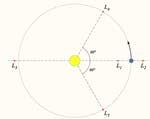4. System Overview
c. Relay Satellite Orbital Considerations :
The relay satellite must keep line-of-sight position stationed at a halo orbit about Lagrangian point L2. Lagrangian points are the positions in interplanetary space where a small object affected by gravitational forces theoretically be stationary relative to two larger objects. The Lagrangian points allow an object that has negligible mass to maintain its position relative to the two massive bodies. In this project the satellite is to be stationed in vicinity of the L2 point behind the Moon orbitting on a circular track that has 3500 km radius. The L2 point is an unstable,collinear point in the system, however the proposed trajectory will be relatively stable and will keep the LOS contact with the observatory and the Earth. The satellite in the orbit will require station keeping maneuvers to maintain proper distance with respect to L2 point. The main disadvantage of the system is that the lifetime of the satellite highly depends on the fuel consumption for station keeping and period control maneuvers. Since the observatory is to be contructed in the Daedalus crater and the position of the crater does not allow us to choose a stable point such as L4 or L5 for the halo orbit. This life time drawback will be taken into account for the cost assumption of the system.

Figure 5 : Lagrangian points in a two body system.

Figure 6 : Earth - Moon halo orbit system (Not drawn to scale)

Figure 7 : Halo orbit configuration